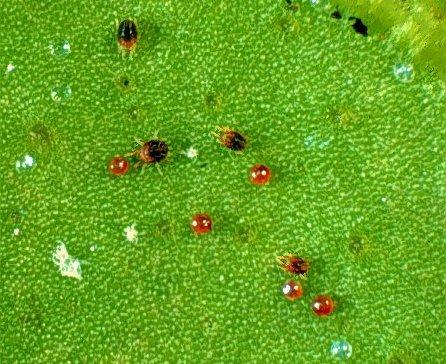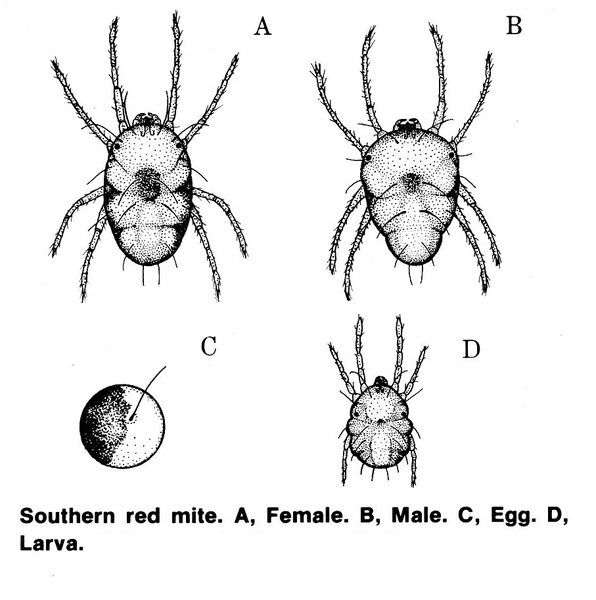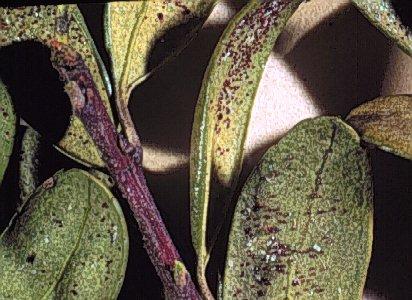General Information
Southern red mites, Oligonychus ilicis, are dark red whereas spruce spider mites Oligonychus ununguis, are almost black with pale yellowish-brown legs. They are called cool weather mites because they seem to do most of their damage in the spring and fall. With their eight legs spread out, these mites would just cover the period at the end of this sentence. Males are smaller and more slender than females. The eggs of these mites are red or brown, round and a little flattened. They have a tiny hair-like "stripe" that sticks up in the center. The larvae of cool weather mites are slightly larger than the eggs and have six legs (Figure 1). Second nymphs are similar to adults and first nymphs are smaller (Figure 2).
Biology
Spruce spider mites are found throughout North America. Southern red mites are found in the eastern United States and California. Southern red mites prefer azaleas, hollies and camellias but they have been recorded from a number of shrubs and herbs. Spruce spider mites feed on junipers, spruce, arborvitae, and other coniferous evergreens.
Southern red mites feed on the lower leaf surface, causing mesophyll collapse. Infested leaves turn gray or brown and may fall prematurely. Heavily infested shrubs may die. Spruce spider mites are the most destructive mite pest of ornamental conifers. Infested needles turn yellow or brown and may drop prematurely. Heavily infested shrubs may be noticeably webbed with silk. After several years of heavy feeding even large trees may be killed.
Spider mites hatch from eggs and develop through a larval stage and nymphal stages before maturing into adults (Figure 4). Males mate with females as soon as the females molt into the adult stage and females soon begin laying eggs. Southern red mites overwinter as eggs glued to the lower leaf surface (Figure 5). If the winter is mild, all stages of this mite may survive. As the weather moderates in late winter, southern red mites increase (Figure 6). Most of the feeding damage occurs in early spring. When populations of predaceous insects and mites are active in summer, southern red mites dwindle away so that only the eggs survive in hot weather. If the summer is mild, all stages of this mite may survive. As temperatures cool in autumn, mite populations build up again.
Spruce spider mites also overwinter as eggs usually laid at the base of needles. In April and May the eggs hatch and larval mites begin feeding. Most feeding damage and reproduction takes place in spring and fall (Figure 7). At upper elevations, the spruce spider mite may be active all summer long.
Control
Because these mites are active in cool weather, infestations should be treated in cool seasons. For best results monitor shrubs in spring and fall for active stages. Spruce spider mites tend to feed on older leaves so that thorough coverage is essential for good control. Some eastern states report spray timing coincides with mid-bloom period of red bud. Two or more treatments at two-week intervals may be necessary for good control. If mites are present in damaging numbers, use one of the following appropriate pesticides. For additional recommendations on chemical use, consult the North Carolina Agricultural Chemicals Manual.
| Active Ingredient | Trade Name | Mite Stage Affected | Labeled Site(s) | Residual | Signal Word | Compatible with Beneficials |
|---|---|---|---|---|---|---|
| abamectin | Avid | immature, adult | G, N, L | Short | Warning | Yes (may be mixed with 1% horticultural oil) |
| acequinocyl | Shuttle | egg, immature, adult | G, N, L | Long | Caution | Yes |
| bifenazate | Floramite | egg, immature, adult | G, N, L, I | Long | Caution | Yes |
| bifenthrin | Talstar | immature, adult | G, N, L, I | Long | Warning | No |
| fluvalinate | Mavrik Aquaflow | immature, adult | G, N, L | Short | Caution | |
| etoxazole | TetraSan | egg, immature, adult | G, N, L, I | Long | Caution | Yes |
| hexythiazox | Hexygon | egg, immature | G, N, L, I | Long | Caution | Yes |
| horticultural oil* | Sunspray, Ultra Fine, and others | immature, adult | G, N, L, I | None | Warning | Yes |
| insecticidal soap* | Safer's, M-Pede, and others | immature, adult | G, N, L, I | None | Warning | Yes |
| spiromesifen | Forbid | egg, immature, adult | L, I | Long | Caution | Yes |
| spiromesifen | Judo | egg, immature, adult | G, N | Long | Caution | Yes |
| G = greenhouse, N = nursery, L = landscape, I = interiorscape * Suitable for home use |
||||||
Recommendations of specific chemicals are based upon information on the manufacturer's label and performance in a limited number of trials. Because environmental conditions and methods of application by growers may vary widely, performance of the chemical will not always conform to the safety and pest control standards indicated by experimental data.
Other Resources
- Insect and Related Pests of Shrubs. Baker, J. R. ed. 1980. NC State Extension publication AG-189.
- Spruce Spider Mite Fact Sheet. Christmas Tree IPM Pest web page, Department of Plant Pathology at Cornell University
- Spruce Spider Mite on Fraser Fir. Sidebottom, J. 2019 (revised). Christmas Tree Notes, NC State Extension publication.
- Water Wands: High Pressure Water Spray Devices for Insect and Mite Control. Drees, B. M. 1991 (about). Texas A&M Agrilife Extension.
- NC State Extension Plant Pathology Publications
- NC State Extension Horticultural Science Publications
- North Carolina Agricultural Chemicals Manual
For assistance with a specific problem, contact your local Cooperative Extension center.
Publication date: Jan. 1, 2011
Reviewed/Revised: Oct. 14, 2019
Recommendations for the use of agricultural chemicals are included in this publication as a convenience to the reader. The use of brand names and any mention or listing of commercial products or services in this publication does not imply endorsement by NC State University or N.C. A&T State University nor discrimination against similar products or services not mentioned. Individuals who use agricultural chemicals are responsible for ensuring that the intended use complies with current regulations and conforms to the product label. Be sure to obtain current information about usage regulations and examine a current product label before applying any chemical. For assistance, contact your local N.C. Cooperative Extension county center.
N.C. Cooperative Extension prohibits discrimination and harassment regardless of age, color, disability, family and marital status, gender identity, national origin, political beliefs, race, religion, sex (including pregnancy), sexual orientation and veteran status.







